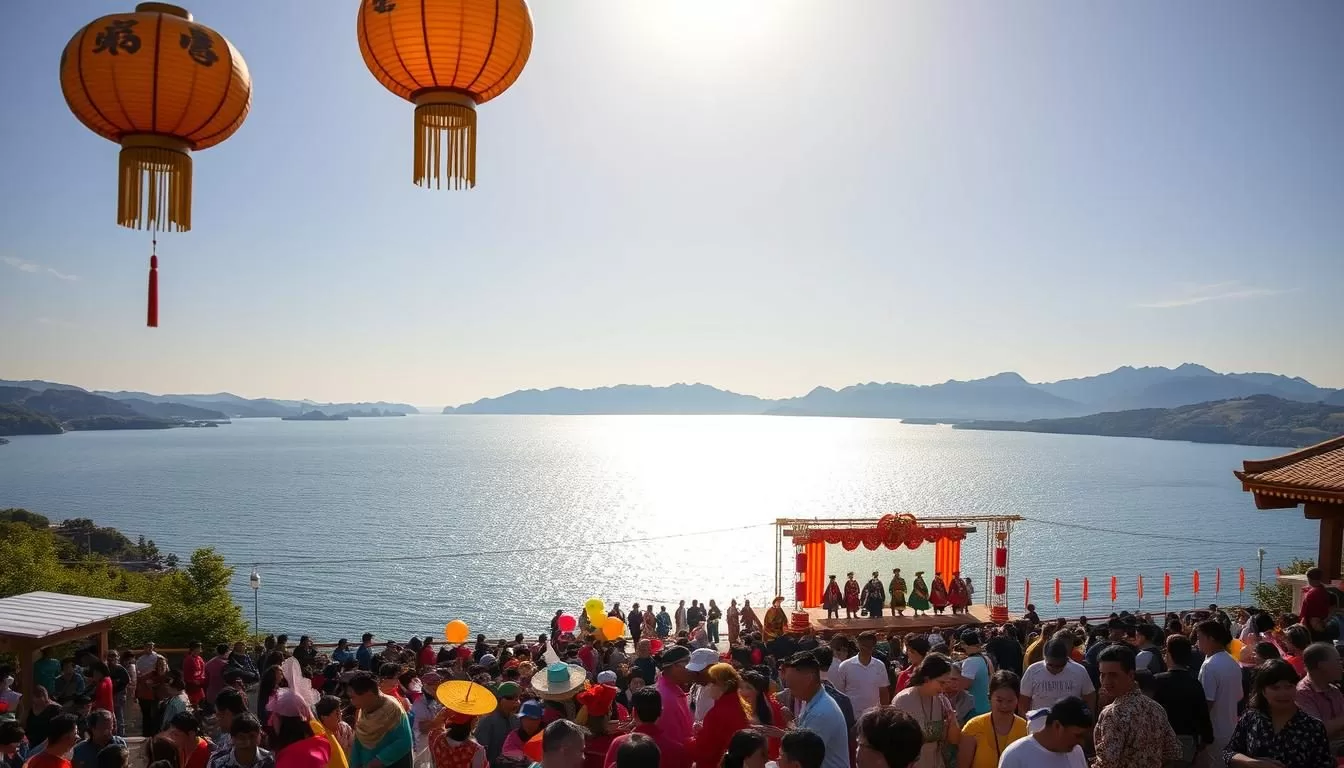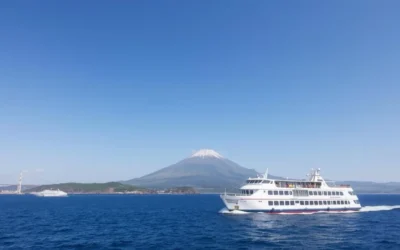✓ Accommodations✓ Flights✓ Rental Cars
You’re about to uncover the hidden gem of Japan’s festival scene, located in the heart of the country. Shiga Prefecture is home to Lake Biwa, Japan’s largest lake, which provides a stunning backdrop for many of the region’s most spectacular festivals.
Throughout the year, Shiga hosts a diverse array of festivals that showcase the region’s rich cultural heritage. From ancient religious ceremonies to modern celebrations, there’s a festival to experience every month. Unlike the often overcrowded festivals in nearby Kyoto, Shiga’s events offer a more authentic and less touristy experience.
This guide will walk you through the best festivals to experience in Shiga Prefecture, organized by season, to help you plan your perfect visit to this culturally rich region of Japan.
Discovering Shiga Prefecture: Japan’s Festival Haven

Located in the heart of Japan, Shiga Prefecture is a captivating destination that seamlessly blends history, culture, and nature. Just a swift train ride away from Kyoto, Shiga Prefecture is an accessible yet often overlooked gem for international travelers.
The region is dominated by Lake Biwa, Japan’s largest freshwater lake, which has profoundly shaped the local culture, economy, and festivals for centuries. With over 37% of its land designated as natural parks, Shiga offers breathtaking natural beauty that serves as the perfect backdrop for its many traditional festivals.
- Shiga Prefecture sits at the heart of Japan, just a short train ride from Kyoto, making it an accessible yet often overlooked destination for international travelers.
- The region is dominated by Lake Biwa, Japan’s largest freshwater lake, which has shaped the culture, economy, and festivals of the area for centuries.
- With over 37% of its land designated as natural parks, Shiga offers you breathtaking natural beauty that serves as the perfect backdrop for its many traditional festivals.
- The prefecture’s strategic location between ancient Kyoto and Tokyo has historically made it a prosperous region, where wealthy merchants and powerful leaders built impressive temples, shrines, and castles.
- These historical sites now host many of Shiga’s most important festivals, giving you a chance to experience celebrations that have continued uninterrupted for hundreds of years.
- Unlike many tourist-heavy destinations in Japan, Shiga provides you with a more authentic glimpse into Japanese culture and traditions through its festivals and events.
By visiting Shiga Prefecture, you can immerse yourself in a rich cultural heritage that is deeply intertwined with its natural surroundings. Whether you’re interested in history, nature, or cultural experiences, Shiga Prefecture has something to offer.
Why Shiga’s Festivals Are Worth Your Time
Shiga’s festivals are a testament to the region’s rich cultural heritage, providing a unique experience for visitors. Unlike larger cities like Kyoto, Shiga’s festivals are generally less crowded, making them more enjoyable.
The prefecture hosts numerous matsuri (religious festivals or festive events) to celebrate nature, worship a god, pray for a good harvest, and pray for good health and prosperity. These events are primarily organized by Shinto shrines and Buddhist temples, as well as local organizations.
| Aspect | Description | Experience |
|---|---|---|
| Cultural Significance | Festivals celebrate nature, harvest, and health | Immerse in authentic Japanese traditions |
| Visual Elements | Elaborate floats, traditional costumes, fire ceremonies | Memorable experiences with spectacular visuals |
| Community Life | Interaction with locals during events | Experience community life in Japan |
Attending Shiga’s festivals gives you the chance to experience authentic Japanese cultural life and enjoy fun events throughout the year. With a variety of festivals happening at different times, you’re sure to find an event that suits your visit.
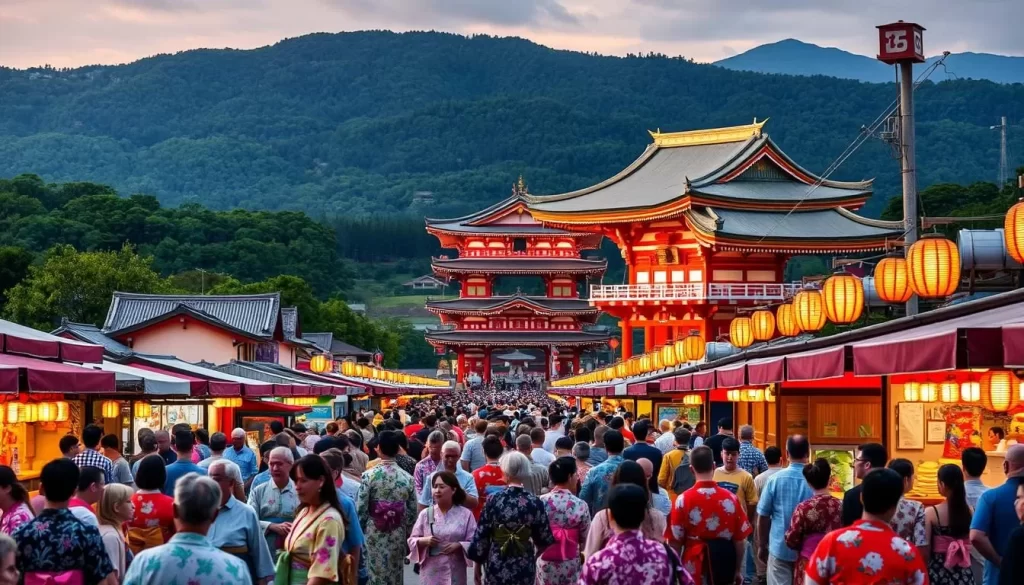
Planning Your Festival Visit to Shiga Prefecture
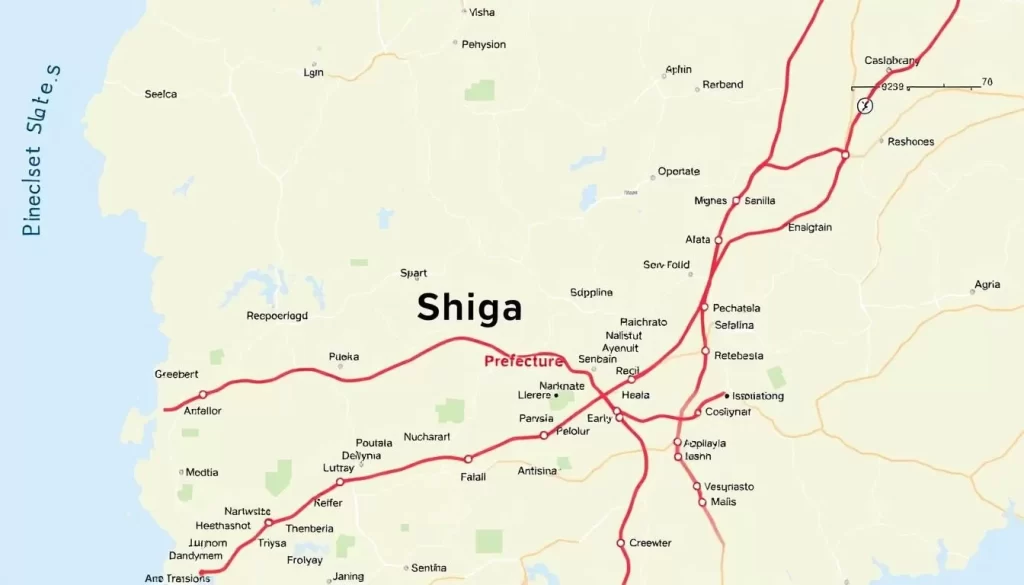
Shiga Prefecture is easily accessible, making it a great destination for festival-goers. You can reach Shiga by shinkansen from major cities like Tokyo, Osaka, and Nagoya.
When planning your trip to Shiga Prefecture, consider the time of year and season. Major festivals occur throughout the year, but are most concentrated in April, May, October, and November.
For the eastern side of Lake Biwa, Maibara Station is your main hub, with local connections to festival locations. For the south and western sides, the JR Tokaido Main Line from Kyoto is the most convenient option. Plan to spend at least 2-3 days to fully experience a festival, and book your accommodations in advance to avoid quick fill-ups during major festival periods.
Spring Festivals in Shiga Prefecture
With the onset of spring, Shiga Prefecture comes alive with a variety of festivals that are not to be missed. The region’s rich cultural heritage is showcased through these vibrant events, offering visitors a unique experience.
Nagahama Hikiyama Festival: UNESCO Cultural Heritage
The Nagahama Hikiyama Festival is a significant event in Shiga Prefecture, recognized by UNESCO as a Cultural Heritage. This festival is a testament to the region’s historical and cultural depth.
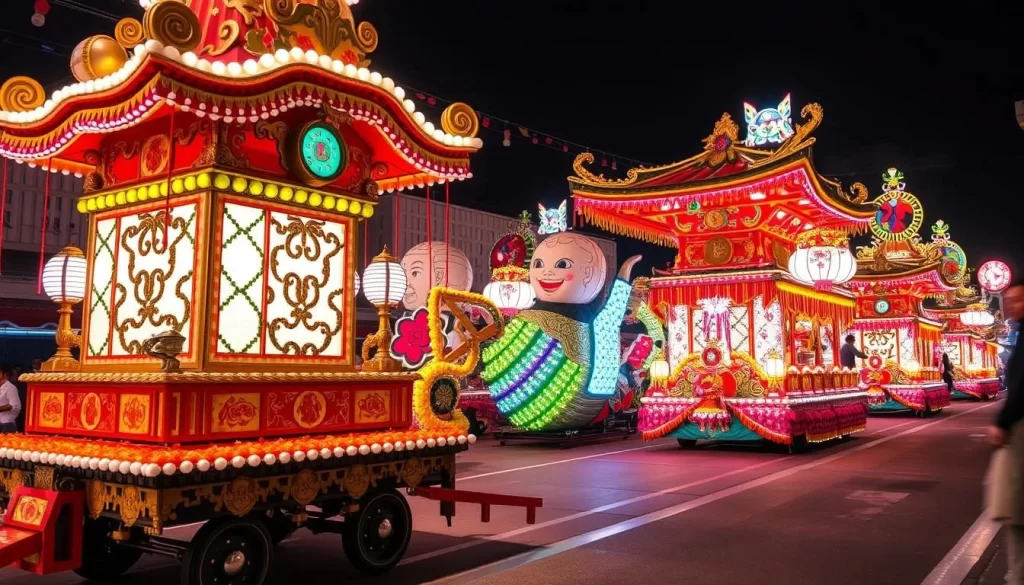
The festival features magnificent floats, known as “hikiyama,” which are decorated with intricate carvings and ornaments. It’s a spectacle that attracts visitors from all over the world.
Sagicho Festival: Omi-Hachiman’s Dramatic Fire Celebration
The Sagicho Festival in Omi-Hachiman is a dramatic fire celebration that marks the end of the New Year. This event is a significant part of the city’s cultural calendar.

The festival involves the ceremonial burning of old New Year’s decorations, symbolizing purification and renewal. It’s a unique and exhilarating experience.
Sanno-sai Festival: Otsu’s Grand Procession
The Sanno-sai Festival, held at Hiyoshi Taisha Shrine in Otsu, is one of Lake Biwa’s three major festivals. It’s a grand celebration that includes various ceremonies and processions.
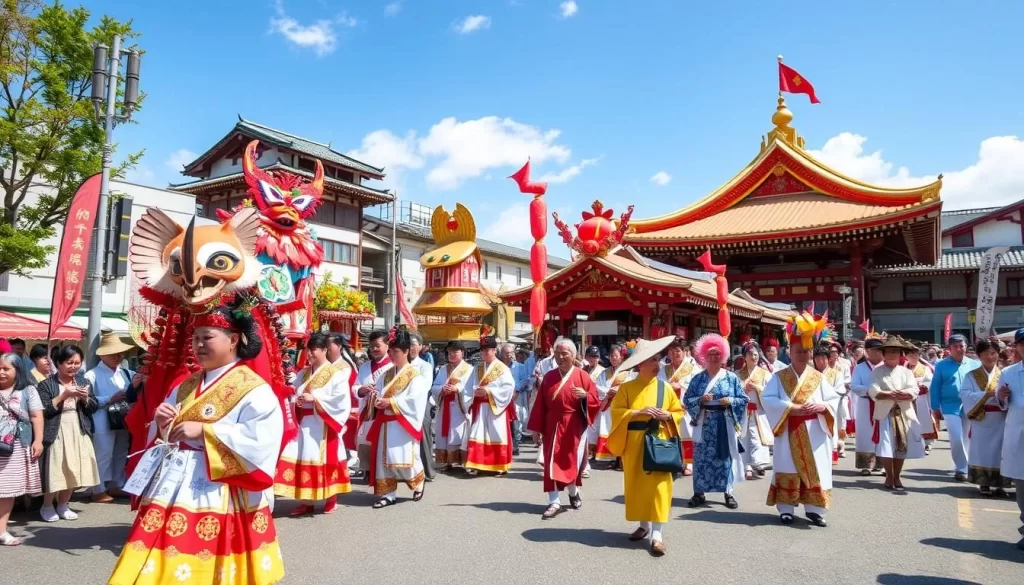
The festival is known for its “violent rocking” of portable shrines and a boat procession on Lake Biwa, blending Shinto and Buddhist traditions. It’s a testament to the region’s rich spiritual heritage.
The Sanno-sai Festival begins on March 1 with preliminary ceremonies, culminating in a three-day extravaganza from April 12 to 14. Visitors can witness various processions throughout the city, including the energetic mikoshi rituals.
The festival’s unique boat procession on Lake Biwa connects the spiritual celebration to the natural beauty of the region, making it a truly unforgettable experience.
Summer Festivals Around Lake Biwa
Lake Biwa, the largest freshwater lake in Japan, hosts a variety of captivating summer festivals. These events showcase the region’s vibrant culture and offer visitors a range of unique experiences.
Biwako Great Fireworks Festival
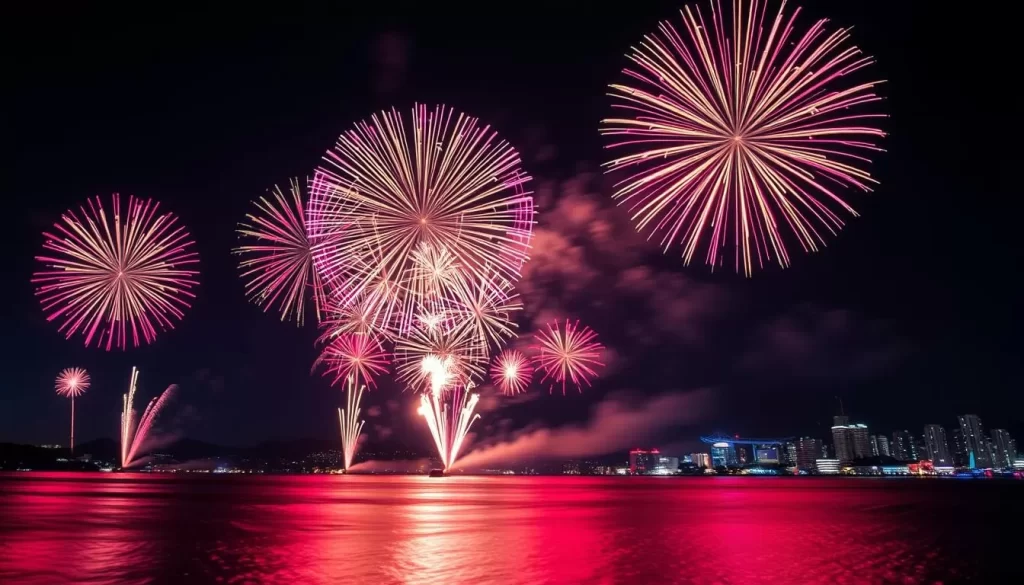
The Biwako Great Fireworks Festival is a highlight of Shiga’s summer, featuring an impressive fireworks display over Lake Biwa. It’s an event that attracts visitors from all over Japan, offering a spectacular view of the night sky lit up with colorful fireworks.
Manto-sai Lantern Festival at Taga Taisha Shrine
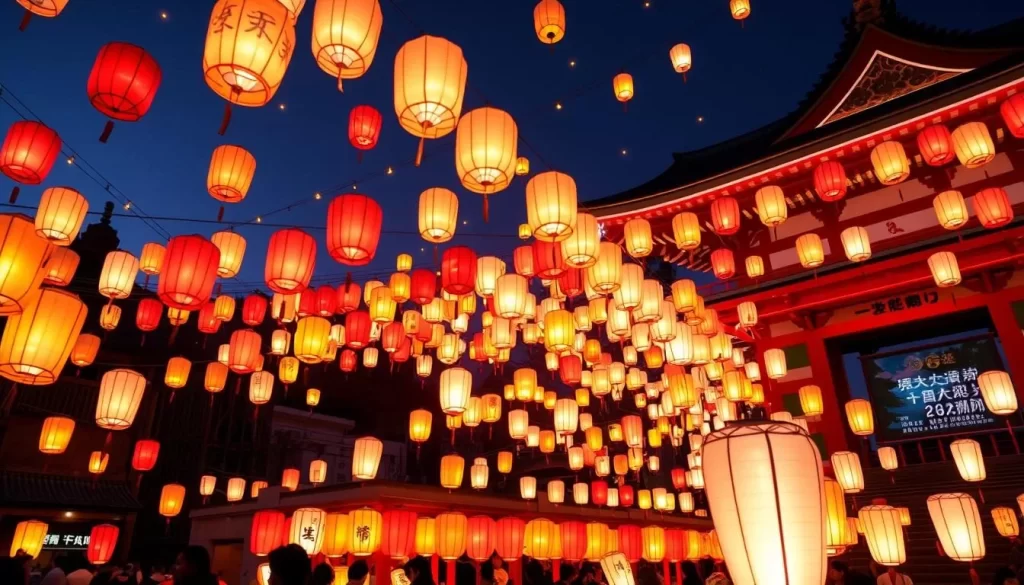
The Manto-sai Lantern Festival, held at Taga Taisha Shrine, is a serene and beautiful event where thousands of lanterns are lit, creating a breathtaking atmosphere. This festival is a unique way to experience the spiritual side of Shiga’s summer culture.
Japan International Birdman Rally in Hikone

The Japan International Birdman Rally, held in late July or early August in Hikone, offers a completely different kind of summer festival experience. Contestants from across Japan compete to see who can fly the furthest over Lake Biwa in their handmade, human-powered flying machines. The event takes place on Matsubara Beach, with Hikone Castle visible in the background, adding a historical touch to this modern spectacle. It’s a fun-filled day that combines technology, creativity, and entertainment.
Autumn Festivals in Shiga
Shiga Prefecture comes alive during autumn with a variety of festivals that are steeped in history and culture. As the seasons change, the region’s vibrant cultural heritage is showcased through numerous celebrations that are worth experiencing.
Otsu Festival: Historic Float Parade
The Otsu Festival is a significant event in Shiga Prefecture, known for its historic float parade. This festival is a spectacle that dates back centuries, featuring elaborate floats that are adorned with intricate designs and historical significance. As you watch the parade, you’ll be treated to a visual feast that highlights the region’s rich cultural heritage.
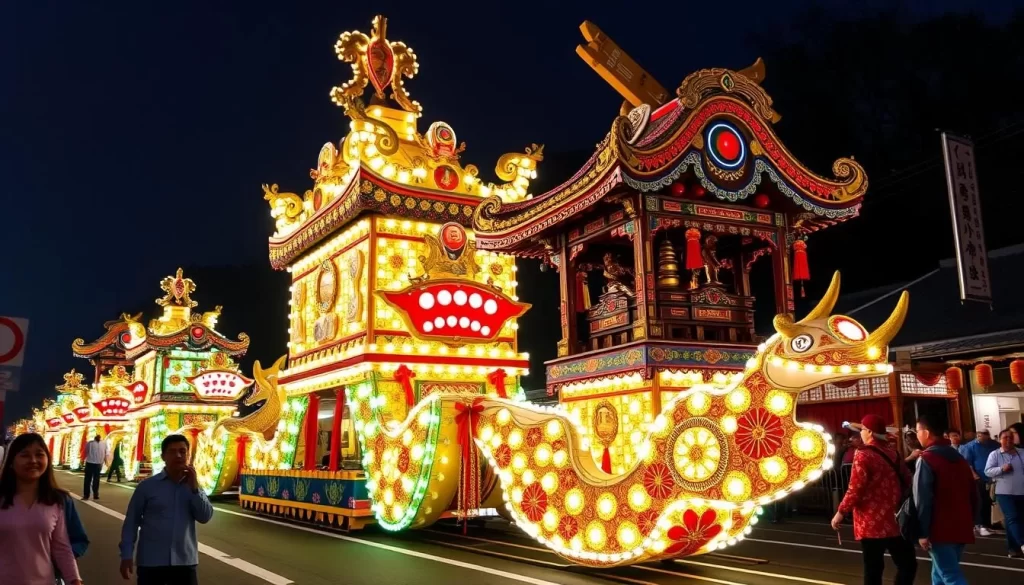
The Otsu Festival is not just a celebration; it’s an immersive experience that connects you with the local community and its traditions. With its historic floats and lively atmosphere, it’s an event that embodies the spirit of Shiga Prefecture’s autumn celebrations.
Kenketo Matsuri: Traditional Dance Celebrations
The Kenketo Matsuri is a unique festival celebrated in various towns across Shiga Prefecture, including Tsuchiyama in Koka and Ryuo. At the heart of this festival is the Kenketo Odori, a traditional dance performed by eight boys aged 7 to 12, who wear distinctive tall peacock feathers on their heads, creating a visually striking performance.
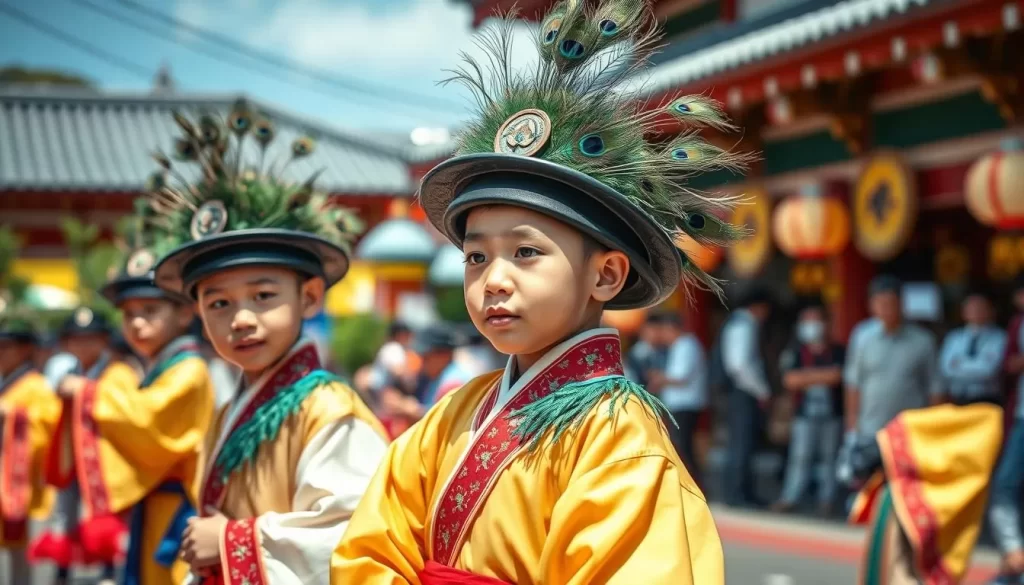
This traditional dance was originally created to ward off calamities and bring good fortune to the community, reflecting the practical spiritual purposes behind many of Japan’s traditional performing arts. In locations like Ryuo, the festival also features a naginata (pole sword) dance, where young boys demonstrate martial movements with these traditional samurai weapons, connecting the celebration to Japan’s warrior heritage.
The Kenketo Matsuri varies slightly from town to town across Shiga Prefecture, giving you the opportunity to experience different local interpretations of this traditional celebration if you visit multiple locations. These performances offer a rare glimpse into traditional Japanese performing arts that are increasingly rare to witness, especially in their authentic community context rather than as tourist performances.
Winter Festivals and New Year Celebrations
Experience the tranquility of Shiga Prefecture in winter, punctuated by vibrant festivals and New Year celebrations. The prefecture comes alive with traditional festivities that offer a glimpse into Japan’s rich cultural heritage.
Hatsumode at Taga Taisha and Omi Jingu
Visiting Taga Taisha and Omi Jingu shrines is a must during the New Year (Hatsumode) in Shiga Prefecture. These shrines are renowned for their historical significance and spiritual ambiance.
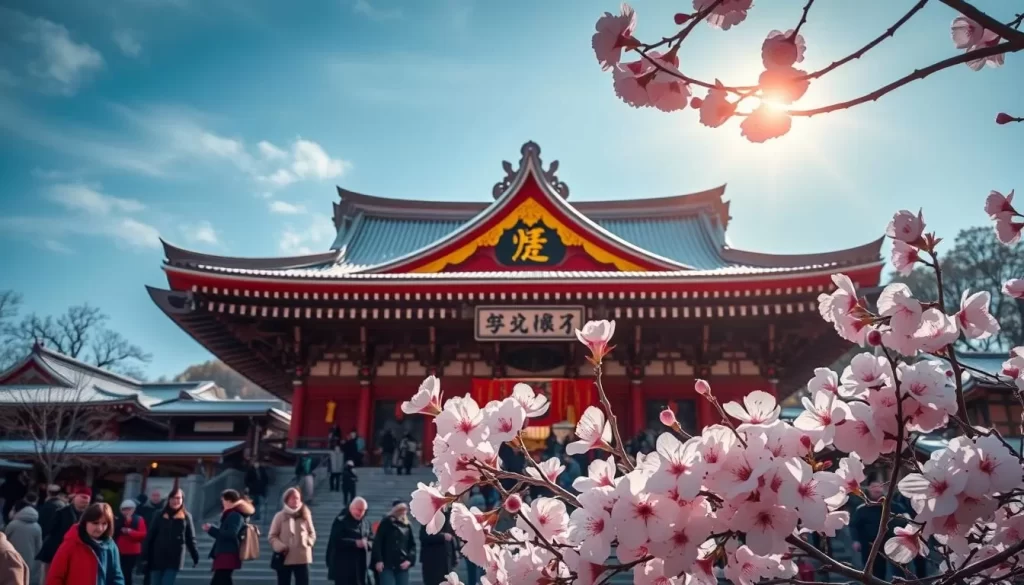
Omi Jingu Karuta Matsuri: Traditional Card Game Tournament
The Omi Jingu Karuta Matsuri, held in early January, is a prestigious tournament celebrating Japan’s traditional competitive card game, karuta. Professional and amateur players gather to compete, showcasing their memory, reflexes, and concentration.
The tournament is significant because Omi Jingu is considered the spiritual home of competitive karuta. Visitors can observe matches, witnessing the speed and intensity of this unique tradition.
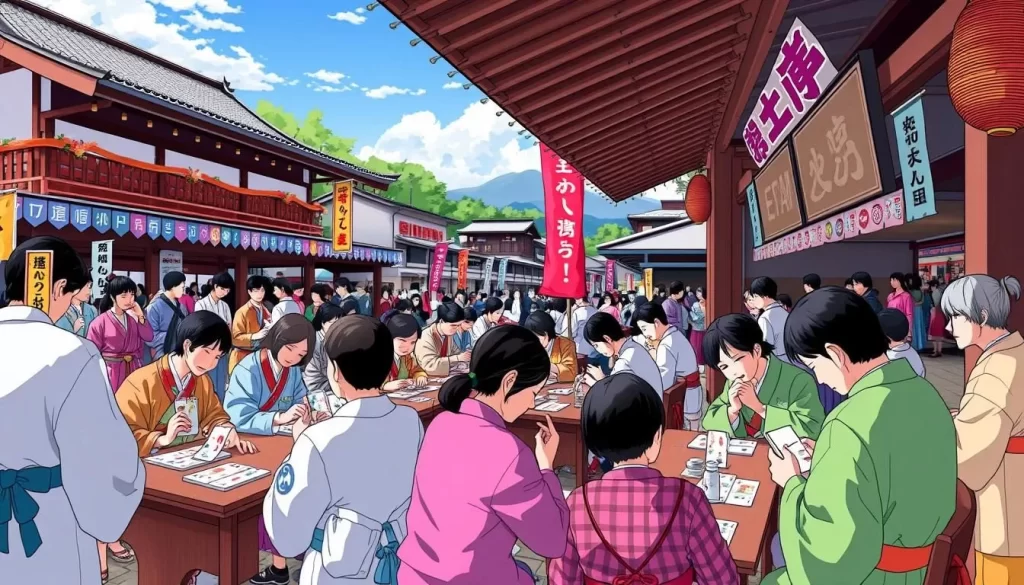
Unique Local Festivals in Shiga Prefecture
The cultural landscape of Shiga Prefecture is dotted with unique local festivals that offer a glimpse into traditional Japan. These events not only celebrate the region’s heritage but also provide visitors with unforgettable experiences.
Hikone Castle Festival Events
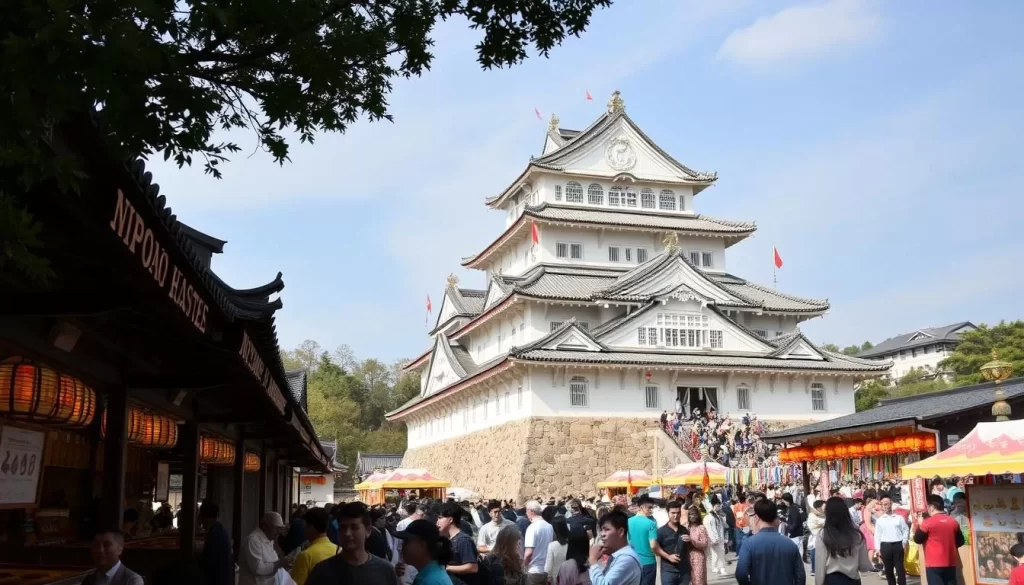
The Hikone Castle Festival is a significant event that takes place within the historic Hikone Castle grounds. It features traditional performances, including martial arts demonstrations and traditional dances, set against the backdrop of the castle’s imposing architecture.
Rice-Planting Festivals: Agricultural Traditions
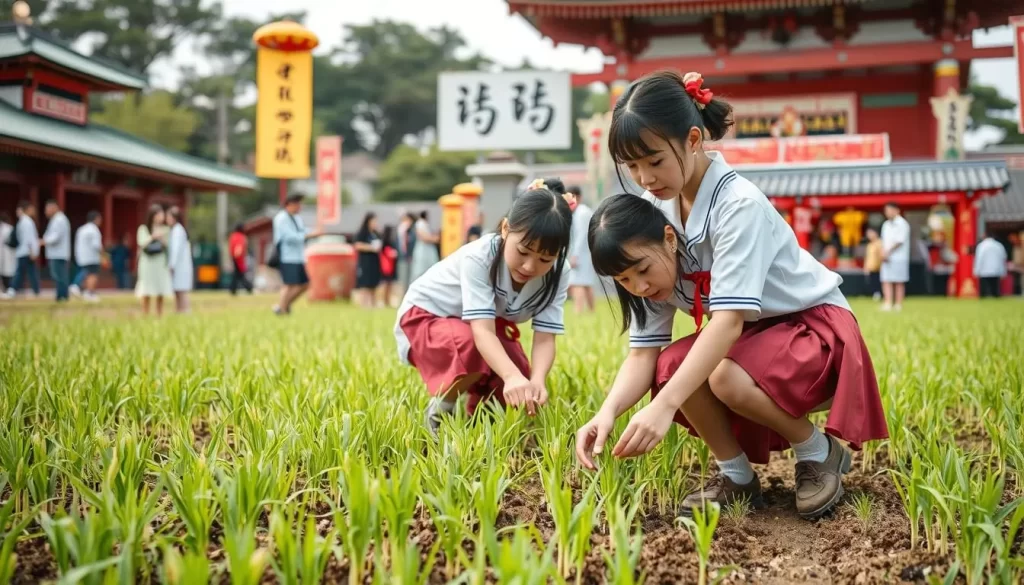
Rice-planting festivals are an integral part of Shiga Prefecture’s cultural heritage, celebrating the region’s agricultural traditions. Two notable events are the Taga Taisha Rice-Planting Festival and the Yuki Saiden Rice-Planting Festival.
The Taga Taisha Rice-Planting Festival, held on the first Sunday in May, features 70 local junior high school girls planting rice seedlings in the shrine’s sacred paddy. The event begins with a ceremony at 1 pm, followed by the rice planting at 2 pm.
The Yuki Saiden Rice-Planting Festival in Yasu, on the fourth Sunday in May, involves men and women in traditional costumes planting rice accompanied by singing, taiko drumming, and dancing. The festival starts with a Shinto ceremony at 10 am.
- Rice-planting festivals in Shiga Prefecture celebrate Japan’s agricultural heritage through ceremonial rice planting in sacred paddies, connecting modern communities to ancient farming traditions.
- The Taga Taisha Rice-Planting Festival continues a tradition that has been maintained for generations, featuring local junior high school girls planting rice seedlings in the shrine’s sacred paddy.
- At the Yuki Saiden Rice-Planting Festival, men and women in colorful costumes plant rice accompanied by singing, taiko drumming, and dancing, creating a multi-sensory cultural experience.
- These festivals begin with Shinto ceremonies that bless the rice paddies and pray for abundant harvests, highlighting the deep connection between Japanese spirituality and agricultural practices.
Combining Festival Visits with Shiga’s Natural Beauty
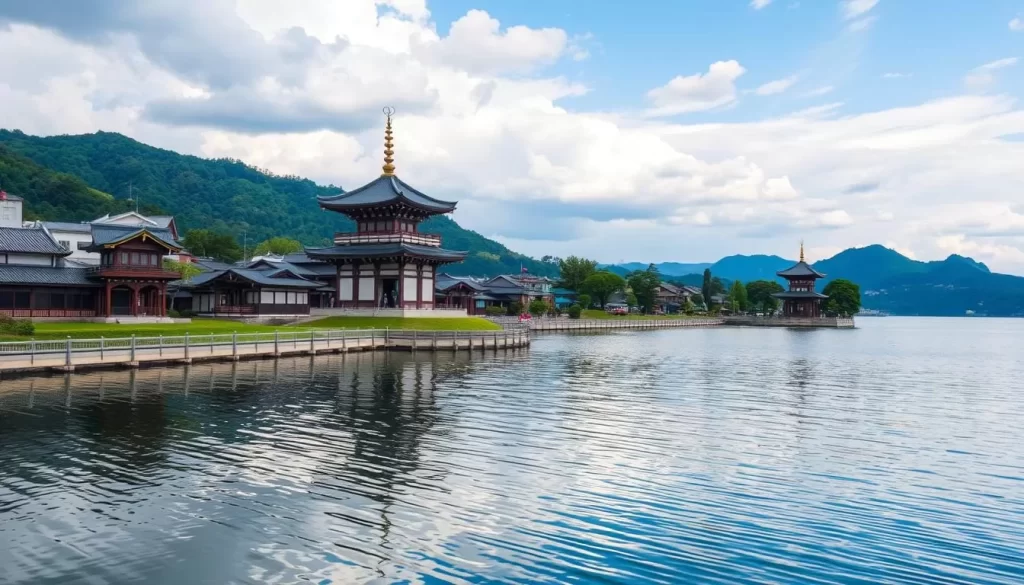
The natural beauty of Shiga Prefecture, including Lake Biwa and the surrounding mountains, provides a picturesque backdrop for its vibrant festivals. With 37% of its land designated as natural parks, Shiga Prefecture is a haven for nature enthusiasts.
You can easily combine cultural festival experiences with outdoor activities such as hiking, cycling, or water activities on Lake Biwa. Many festival locations, like Hikone Castle, are situated in areas of natural beauty, allowing you to appreciate both cultural and natural attractions in a single visit.
Seasonal natural attractions complement the festivals throughout the year, from cherry blossoms in spring to snow-capped mountains in winter. This blend of culture and nature makes Shiga Prefecture an ideal destination.
Where to Stay During Festival Season in Shiga

Finding the perfect place to stay in Shiga during festival season can enhance your overall trip experience. Accommodation options range from traditional ryokan to modern hotels, depending on which festival you’re attending.
For major festivals, it’s essential to book your accommodations well in advance, as local options fill up quickly with both domestic and international visitors. Consider staying in main cities like Otsu, Hikone, or Nagahama for the most options.
For an authentic experience, look for smaller ryokan or minshuku in the town itself, which often include traditional Japanese meals and put you in the center of celebrations.
Local Foods to Try at Shiga Prefecture Festivals
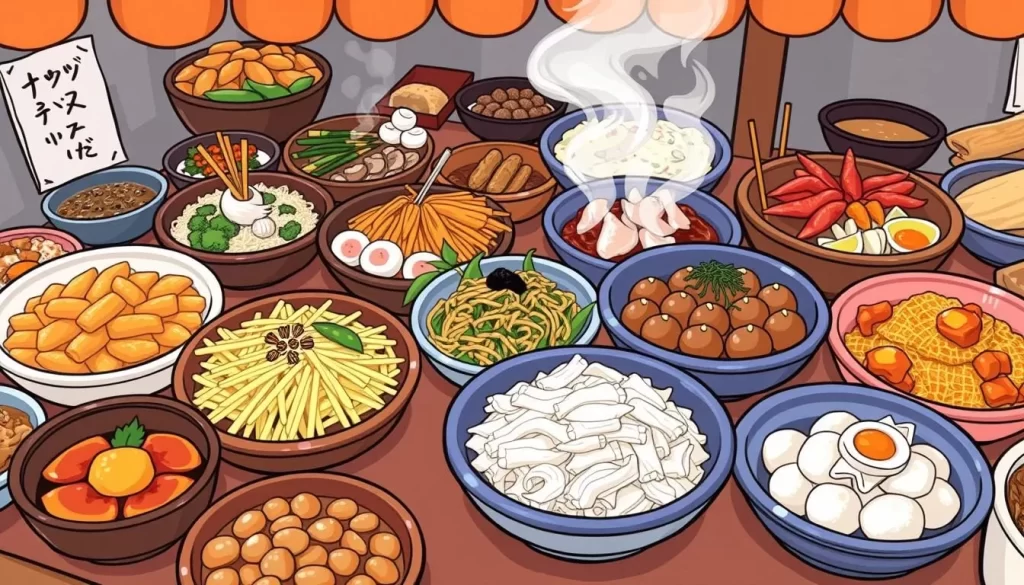
The festivals in Shiga Prefecture are not just visually stunning but also a treat for your taste buds. Festival food stalls, or yatai, offer a delicious way to experience local culinary traditions that reflect the region’s agricultural bounty and proximity to Lake Biwa.
Be sure to try funazushi, Shiga’s most famous local delicacy—a fermented sushi made from crucian carp from Lake Biwa. Festivals celebrating the rice harvest feature special mochi preparations. You can also find Omi beef, one of Japan’s top three wagyu beef varieties, and seasonal specialties like wild mountain vegetables, ayu (sweetfish), and matsutake mushrooms.
Tips for an Authentic Festival Experience in Shiga
With relatively smaller crowds compared to Kyoto’s festivals, Shiga’s events provide an ideal setting for an authentic festival experience. To make the most of your visit, consider arriving early to observe the preparations and rituals that take place before the main events begin. This will give you a deeper understanding of the festival’s significance.
Learning a few basic Japanese phrases related to festivals can also enhance your experience. Simple greetings and expressions of appreciation will go a long way in showing respect for local traditions. Dressing appropriately for the season and festival type is also essential, with comfortable shoes being a must. For summer festivals, consider wearing yukata to fully immerse yourself in the local culture.
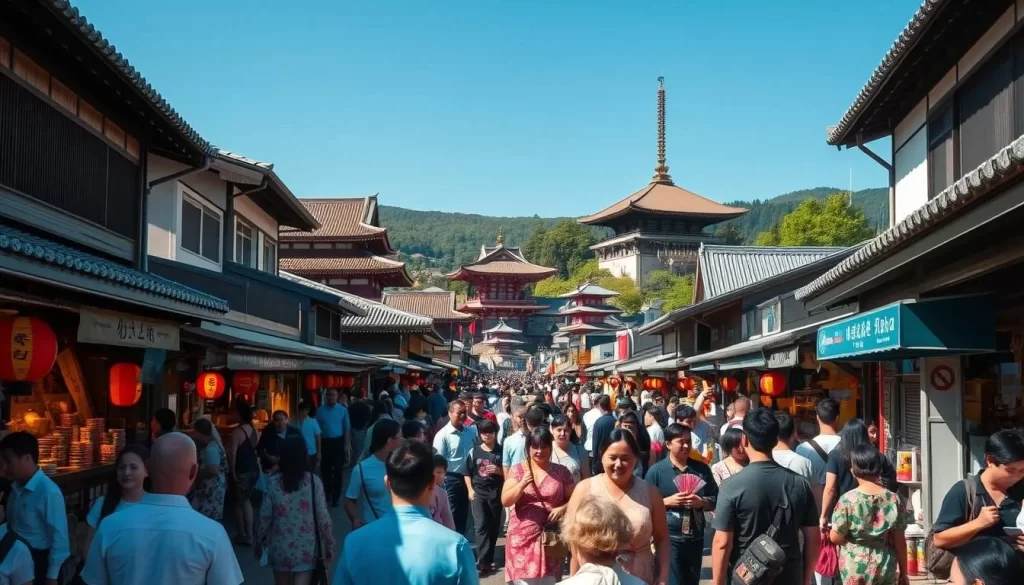
Being mindful of festival etiquette, such as following the crowd flow and respecting restricted areas, will also contribute to a smoother experience. Take your time to understand the meaning behind festival activities, and don’t hesitate to join in participatory elements when appropriate. This way, you’ll have a more immersive and memorable festival experience in Shiga.
Conclusion: Making the Most of Shiga’s Festival Culture
As you explore the rich cultural tapestry of Shiga Prefecture, you’ll discover a world of vibrant festivals that embody the essence of Japan’s heritage. Shiga Prefecture’s culture offers a unique window into authentic Japanese traditions, preserved for centuries and often less commercialized than in major tourist destinations.
By participating in these events, you’ll gain a deeper understanding of the local community and have a fun and memorable experience. The diversity of Shiga’s festivals ensures that there’s something to capture your interest, whether you’re drawn to the artistic beauty of festival floats or the excitement of fireworks over Lake Biwa.
With its rich cultural heritage and diverse festivals, Shiga Prefecture promises a rich, rewarding, and fun dimension to your Japanese travel experience. So, plan your visit around these festivals to create unforgettable memories.
The above is subject to change.
Check back often to TRAVEL.COM for the latest travel tips and deals.
